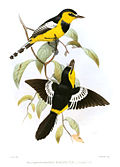| Pachycephala | |
|---|---|
 | |
| Adult male rufous whistler (Pachycephala rufiventris) | |
| Scientific classification | |
| Domain: | Eukaryota |
| Kingdom: | Animalia |
| Phylum: | Chordata |
| Class: | Aves |
| Order: | Passeriformes |
| Family: | Pachycephalidae |
| Subfamily: | Pachycephalinae |
| Genus: | Pachycephala Vigors, 1825 |
| Type species | |
| Muscicapa pectoralis Latham, 1801 | |
| Synonyms | |
| |
Pachycephala is a genus of birds native to Oceania and Southeast Asia. They are commonly known as typical whistlers. Older guidebooks may refer to them as thickheads, a literal translation of the generic name, which is derived from the Ancient Greek terms pachys "thick" + kephale "head". This lineage originated in Australo-Papua and later colonized the Indonesian and Philippine archipelagos to the west and the Pacific archipelagos to the east. [1]







